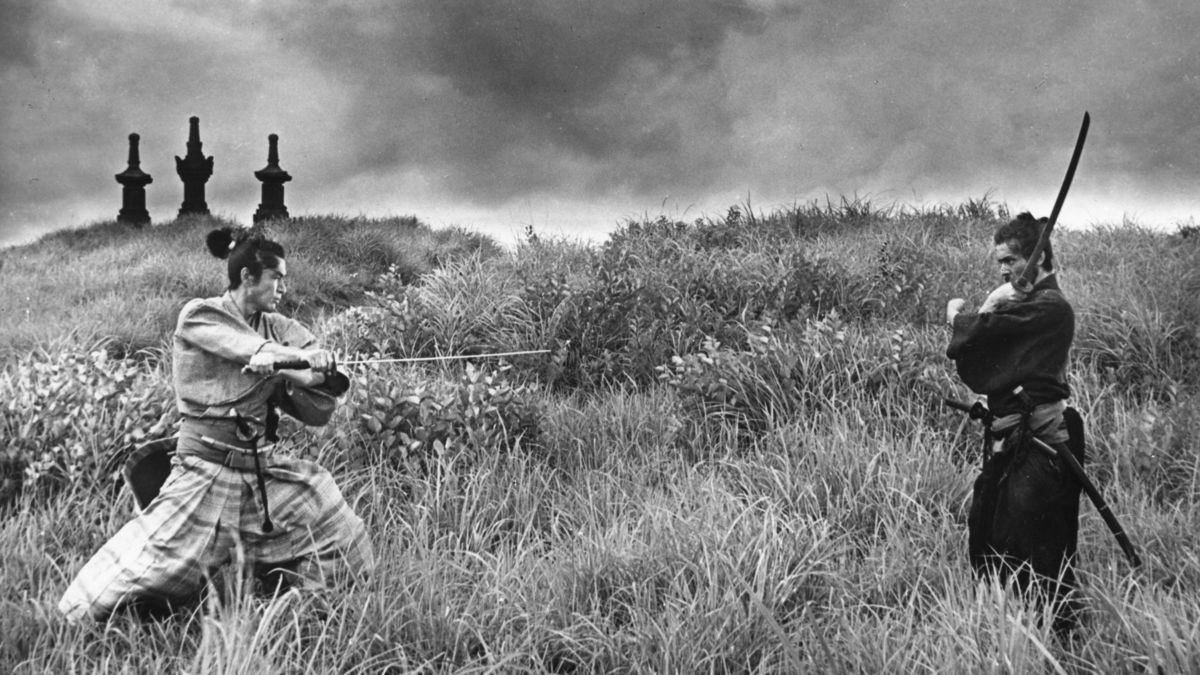Welcome to our Colossus Movie Guide for Harakiri. This guide contains everything you need to understand the film. Dive into our detailed library of content, covering key aspects of the movie. We encourage your comments to help us create the best possible guide. Thank you!
What is Harakiri about?
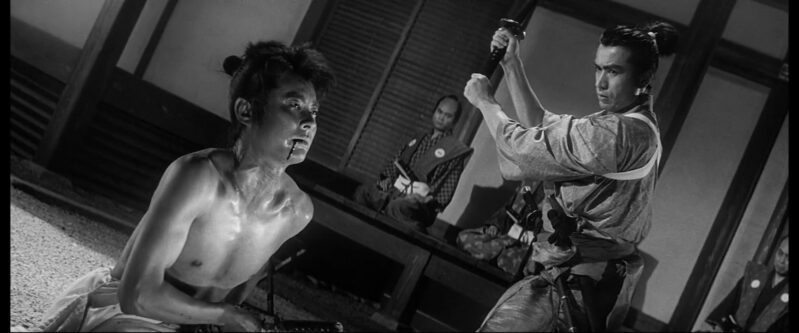
Harakiri, a film set in the Edo period of Japan, uses its narrative to expose societal hypocrisy and challenges the oppressive class hierarchy prevalent during this era. The film emphasizes the idea of an individual’s honor being subjected to the whims of a socially established order. This theme of honor is not just in the context of the samurai code, but also in how the impoverished samurai, Tsugumo Hanshirō, in a state of desperation, resorts to challenging these societal norms in an effort to maintain his personal dignity.
Harakiri deepens its exploration of societal norms by addressing the theme of morality. It questions the collective morality of a society that expects its members to uphold honor and virtue but doesn’t reciprocate with the same level of empathy or understanding. It presents a critique of an unfeeling society that imposes stringent, oppressive standards on its individuals, but shows no concern for their personal hardships or suffering. It is this paradox, the juxtaposition of personal honor against the backdrop of an apathetic society, that forms the crux of Harakiri. It provokes the audience to reconsider their understanding of honor, morality, and the compromises one must make when caught between the two.
Movie Guide table of contents
Cast
- Tatsuya Nakadai – Tsugumo Hanshirō (津雲 半四郎)
- Rentarō Mikuni – Saitō Kageyu (斎藤 勘解由)
- Akira Ishihama – Chijiiwa Motome (千々岩 求女)
- Shima Iwashita – Tsugumo Miho (津雲 美保)
- Tetsurō Tamba – Omodaka Hikokuro (沢潟 彦九郎)
- Ichirō Nakatani – Yazaki Hayato (矢崎 隼人)
- Masao Mishima – Inaba Tango (稲葉 丹後)
- Kei Satō – Fukushima Masakatsu (福島 正勝)
- Yoshio Inaba – Chijiiwa Jinai (千々岩 陣内)
- Yoshiro Aoki – Kawabe Umenosuke (川辺 右馬介)
- Shinobu Hashimoto – Writer
- Masaki Kobayashi – Director
The ending of Harakiri explained
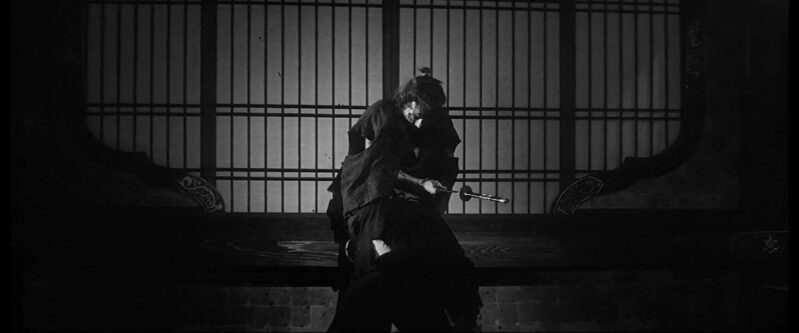
A recap of Harakiri‘s ending
After exposing bushido, the samurai moral code, as a sham and triggering Saitō’s laughter, Hanshirō unveils the rest of his story. He admits to seeking out Hayato and Umenosuke before arriving at the Iyi estate, disheveling their hair by cutting off their topknots. He also battled Hikokuro, who had respectfully challenged him, resulting in another broken sword and lost topknot. Hanshirō produces these topknots as evidence, throwing them in the courtyard and challenging the clan’s honor.
A furious Saitō, feeling his clan’s reputation tarnished, orders his men to kill Hanshirō. Despite his valiant resistance, in which he eliminates four samurai, injures eight, and shatters the symbolic suit of armor, Hanshirō is finally cornered. Instead of swords, the clan uses three matchlock guns to execute him as he commits seppuku.
Worried about potential disgrace, Saitō orders all of Hanshirō’s inflicted casualties to be reported as illness-induced deaths. Simultaneously, news arrives that Hikokuro committed suicide, while Hayato and Umenosuke are pretending to be ill. Saitō insists they should also commit seppuku for their dishonor, with their deaths attributed to “illness”.
In the aftermath, the battered armor is restored and official records are amended. Hanshirō and Motome’s deaths are recorded as suicides due to mental instability. The Shōgun commends the Iyi clan for their handling of the incidents, praising their exemplification of bushido. As the cleanup continues, a worker discovers a topknot, a silent testament to the day’s events.
Hanshirō’s Act of Rebellion
The climax of Harakiri begins with Hanshirō’s defiant act of rebellion, where he disrobes the Iyi clan of their honor by exposing the topknots of three samurai he had previously encountered. This act isn’t just an expression of personal revenge, but a calculated challenge to the clan’s superficial understanding of honor and their rigid enforcement of Bushido.
Hanshirō’s exposition of the samurai moral code as a façade is a significant turning point in the narrative. He openly criticizes the hypocrisy of the Iyi clan’s interpretation of Bushido, highlighting their prioritization of empty symbolism over empathy and fairness. This confrontation is a daring defiance against the oppressive power structure and an act of resistance against the marginalization experienced by the lower-class samurai.
Moreover, his confrontation illuminates the contrast between honor as an external societal expectation and honor as a personal ethical compass. The revelation of the topknots embodies this challenge – an act seen as deeply dishonorable by the samurai, yet carried out by Hanshirō to expose the moral bankruptcy of those who claim to uphold honor.
Implications of the Battle
The ensuing battle, where Hanshirō is ordered to be killed, is a showcase of the conflict between the individual and the oppressive societal system. Despite being outnumbered, Hanshirō manages to hold his own, symbolizing the power of personal honor and courage in the face of overwhelming odds.
In his last stand, Hanshirō goes beyond physical confrontation and strikes at the symbolic heart of the clan by destroying the antique suit of armor. This armor represents the Iyi clan’s glorified past and their claim to honor and tradition. Its destruction signifies the dismantling of these illusions and further underscores Hanshirō’s critique of the hollow concept of honor upheld by the clan.
The manner in which Hanshirō is finally cornered and killed, not with swords but with matchlock guns, is poignant. This departure from samurai tradition encapsulates the themes of power and class disparity, showing the lengths the powerful will go to maintain their control. Hanshirō’s act of seppuku, performed under the fire of guns, is a final, tragic testament to the destructive cycle of honor and sacrifice imposed by the samurai code.
The Lasting Impact of Hanshirō’s Defiance
In the aftermath of the battle, the Iyi clan’s reaction further elucidates the film’s exploration of honor as a societal construct. Terrified of public disgrace, Saitō orders all of Hanshirō’s inflicted casualties to be reported as illness-induced deaths. This action, while on the surface may seem pragmatic, is an embodiment of the illusion of honor that the clan clings to.
The clan’s attempt to conceal the truth shows their concern for preserving their reputation, even in the face of clear evidence of their dishonor. This cover-up emphasizes how the power structures in society can manipulate narratives and uphold false ideals at the expense of truth and justice.
Simultaneously, the Shōgun’s commendation of the clan’s handling of the incidents further underlines the pervasiveness of this illusion. The superficial glorification of honor persists, further perpetuating the oppressive cycle.
Finally, the act of cleaning and re-erecting the armor symbolizes a stubborn attempt to restore the status quo, reaffirming the societal resistance to change. Despite the shattered illusions and the revealed hypocrisy, the clan tries to mend its image, an act which echoes the systemic and cyclical nature of societal norms and structures.
Hanshirō and Motome’s deaths being recorded as suicides due to mental instability is a deliberate erasure of their narratives, an act that further underscores the silencing and marginalization of lower-class samurai. This also serves as a critique of how societal narratives are often manipulated to preserve the status quo and protect the powerful at the expense of the marginalized.
The final image of a worker finding a severed topknot is a potent one. Even as the blood is scrubbed from the ground and the official records are rewritten, the physical evidence of the day’s events, the topknot, remains, symbolizing the lasting impact of Hanshirō’s defiance. This subtle reminder of the true events of the day, hidden within a work bucket, is a stark contrast to the carefully crafted narrative of honor and valor presented to the world.
The themes and meaning of Harakiri
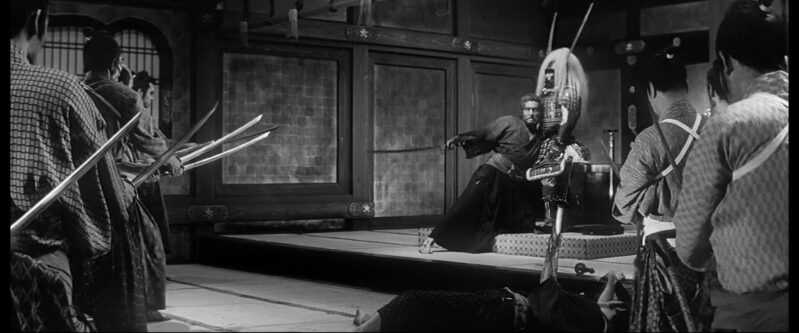
The Disparity of Power and Class
One of the predominant themes explored in Harakiri is the disparity of power and class within the context of Edo period Japan. The film meticulously showcases the social order’s rigidity, especially towards the samurai class, who find themselves in dire straits during a time of peace, rendered obsolete and often impoverished.
In the film, we see how this disparity manifests itself primarily through the character of Tsugumo Hanshirō, an unemployed samurai, or rōnin. He is forced to navigate an unyielding society that offers him no respite from his dire situation, yet expects him to uphold his honor as per the samurai code. His struggle is symbolic of the struggle of many samurais of the time, caught in the cruel paradox of needing to uphold honor in a society that has deprived them of the means to do so.
The class disparity is further highlighted through the characters of the Iyi clan, who represent the privileged and powerful samurai households. The disparity between their lofty ideals and the ground reality of the society they preside over is a recurring theme in the movie. Their adherence to the traditional samurai code becomes a tool of oppression rather than a guideline for a dignified life, as they exploit it to maintain their power and privilege, often with cruel consequences for those less fortunate.
The Iyi clan’s reaction to Hanshirō’s request to commit harakiri in their courtyard also serves as a powerful commentary on the class divide. The clan, initially assuming that he is trying to bluff his way into receiving charity, treats him with suspicion and scorn. This response further emphasizes the disconnect between the powerful and the powerless, and the lack of understanding or empathy from the former for the plight of the latter.
The Tragedy of the Samurai Code
Another important theme Harakiri delves into is the tragedy inherent in the samurai code of honor, or Bushido. Bushido emphasizes virtues like loyalty, courage, veracity, and honor unto death, and was considered the guiding principle of a samurai’s life. However, the film portrays how these noble ideals can become a burden when the samurai find themselves unable to fulfill their societal roles due to circumstances beyond their control.
This tragedy is vividly depicted in the plight of Motome Chijiiwa, Hanshirō’s son-in-law. Motome’s desperate act of trying to sell his bamboo blades to feed his family is seen as a betrayal of the samurai code, but it’s a situation he’s been forced into by the very society that enforces this code. His subsequent forced harakiri with his bamboo blade is a gruesome representation of the destructive impact of rigid societal norms.
Hanshirō himself serves as a potent symbol of this tragic theme. His life, marked by loss and poverty, is an embodiment of the tragedy of a samurai living in a society that has ceased to value him. The film thus offers a poignant critique of a system that values a code of honor more than human lives, where individuals are compelled to take desperate measures, like harakiri, to uphold their honor.
The Illusion of Honor
Harakiri powerfully critiques the concept of honor and how it is often used as a tool of societal control. The film systematically dismantles the idea that honor is an absolute value, suggesting instead that it’s a constructed ideal, often manipulated by those in power to maintain their status quo.
The Iyi clan, for instance, upholds the concept of honor as an absolute, and they expect every samurai to adhere to it regardless of their circumstances. However, the film shows this interpretation of honor to be rigid and unsympathetic, lacking any consideration for human suffering or hardship. They enforce harakiri on Motome, despite his clear desperation and inability to perform the ritual properly, because they prioritize the maintenance of the abstract principle of honor over compassion or empathy. This rigid and dehumanizing adherence to “honor” is depicted as a tool of oppression, rather than a system of ethics or morality.
In contrast, Hanshirō’s view of honor is deeply personal and rooted in the lived experiences of individuals. To him, honor isn’t an abstract ideal but an intimate part of his humanity, defined by his actions, integrity, and how he treats others. When he confronts the Iyi clan, he exposes the hollowness of their interpretation of honor, as their actions do not align with the compassion, integrity, or loyalty that true honor would encompass.
The film also comments on the illusion of collective honor, whereby a community or a clan’s honor is held above the welfare of individuals. The Iyi clan is more concerned with protecting its reputation than with acknowledging the systemic issues leading samurais like Hanshirō and Motome to their desperate acts. They are willing to go to great lengths to maintain this illusion of collective honor, even if it means silencing dissent and causing suffering. This critique of collective honor highlights the societal tendency to maintain the appearance of respectability and honor, often at the expense of individual well-being and justice.
Why is the movie called Harakiri?
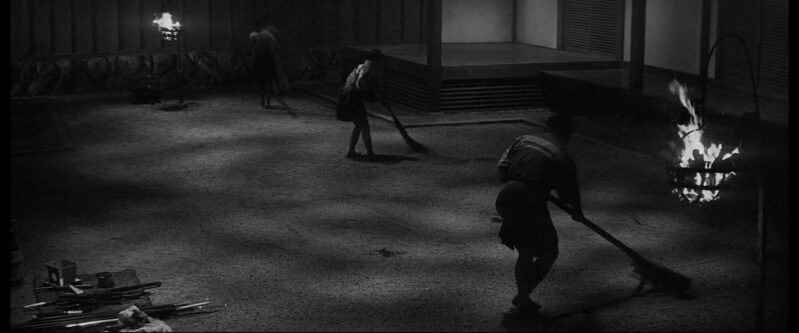
The title Harakiri, which translates to “belly cutting,” is a stark and unsettling term for a form of ritual suicide by disembowelment, more formally known as seppuku, practiced by samurai in feudal Japan. The act was performed by the samurai to restore honor to his family following disgrace or failure. This vivid and rather violent term as a title sets the tone for the thematic exploration of the film. It establishes a psychological backdrop against which the narrative unfolds, inviting the audience to question the notions of honor, sacrifice, and the brutal norms that society often accepts without question.
At the core of Harakiri is Tsugumo Hanshirō, a character who is emblematic of the struggle faced by samurais during the time of peace in the Edo period. His contemplation and eventual engagement in the act of harakiri expose the internal torment and desperation experienced by those marginalized in a society that has ceased to value their role. In this context, the title represents not only the physical act of harakiri but also metaphorically stands for the mental and emotional “disembowelment” the character goes through as he grapples with his circumstances and societal norms.
However, the title Harakiri serves a deeper purpose than just indicating the historical context or Hanshirō’s struggle. It underscores the film’s overarching exploration of the paradoxical aspects of the samurai code of honor. The societal norm expects the samurais to endure extreme suffering and even choose death over the loss of honor, while the very same society remains indifferent to their plight. This indifference is cruelly ironic, further amplified by the title’s emphasis on the act of self-destruction as a tool for redemption.
Furthermore, the title Harakiri acts as a critique of society’s blind adherence to tradition. The act of harakiri, a brutal and arguably outdated ritual, symbolizes the oppressive societal norms to which the characters in the movie are expected to conform. By choosing this as the title, the film spotlights the societal structures that uphold these norms, and the often devastating consequences they have on the lives of individuals.
Lastly, Harakiri in its broader implications points to the existential dilemma faced by samurai in the peaceful Edo period. Stripped of their purpose as warriors, yet bound by the stringent code of Bushido, many samurai found themselves in a no-win situation, where their only perceived path to honor was through harakiri. The title thus encapsulates the paradox of a warrior bound by honor, but deprived of the means to live honorably.
Important motifs in Harakiri
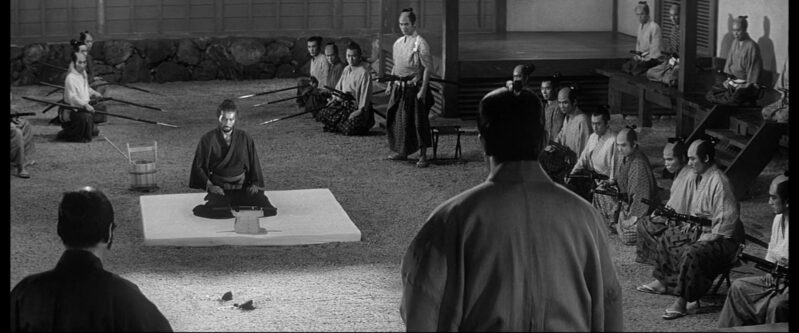
The Topknot
The topknot in Harakiri serves as a critical motif that encapsulates the theme of honor as an external societal expectation. This hairstyle, traditionally worn by samurai, was a symbol of their status and honor. Hanshirō’s act of cutting off the topknots of three samurai signifies an affront to their honor. However, his purpose is not merely to humiliate; it is a calculated action meant to expose the hollowness of such external symbols of honor. The act of revealing the topknots in the courtyard of the Iyi clan is a defiant challenge to the clan’s superficial understanding of honor and Bushido, and an indictment of their rigid, oppressive power structure.
The Bamboo Sword
Motome’s bamboo sword is another potent motif in the film. As a symbol of a samurai’s honor and martial prowess, the fact that Motome’s sword is made of bamboo and not steel is an indictment of his poverty and desperate circumstances. It embodies the bleak reality of lower-class samurais during the era, while also symbolizing the societal neglect and disregard for their plight. When forced to commit seppuku with his bamboo sword, the horrific scene underscores the theme of systemic oppression and the dehumanizing consequences of rigid adherence to abstract ideals of honor.
The Armor
The antique armor, symbolic of the Iyi clan’s heritage and claimed honor, is a recurring motif. It stands as a testament to the clan’s glorified past and their adherence to tradition. However, Hanshirō’s act of smashing the armor during his last stand serves as a powerful act of defiance. It signifies the dismantling of the clan’s illusions of honor and the empty glorification of their past, aligning with the film’s critique of societal norms and hollow interpretations of honor.
The Courtyard
The courtyard of the Iyi clan serves as the stage for key events in Harakiri, from Motome’s tragic forced seppuku to Hanshirō’s defiant showdown. As such, it transforms into a motif symbolizing the arena where the individual confronts the societal system. The very neutrality of this space, where the clan enforces its rules and norms, underscores the themes of power, class disparity, and systemic oppression that run throughout the film. The courtyard bears silent witness to both the physical confrontations and the ideological battles waged within its confines.
Illness
“Illness” is a significant motif, employed by the Iyi clan as a euphemism to cover up the violent deaths inflicted by Hanshirō and to conceal their own dishonor. It’s a metaphor for the clan’s attempts to whitewash their actions and manipulate the narrative, preserving their reputation at the expense of truth and justice. This motif aligns with the film’s exploration of societal manipulation of narratives and the illusion of honor. The recurrence of “illness” as a cause of death in the official records symbolizes the clan’s — and by extension, society’s — determination to uphold false ideals and maintain the status quo, further emphasizing the film’s critique of societal norms.
Questions & answers about Harakiri
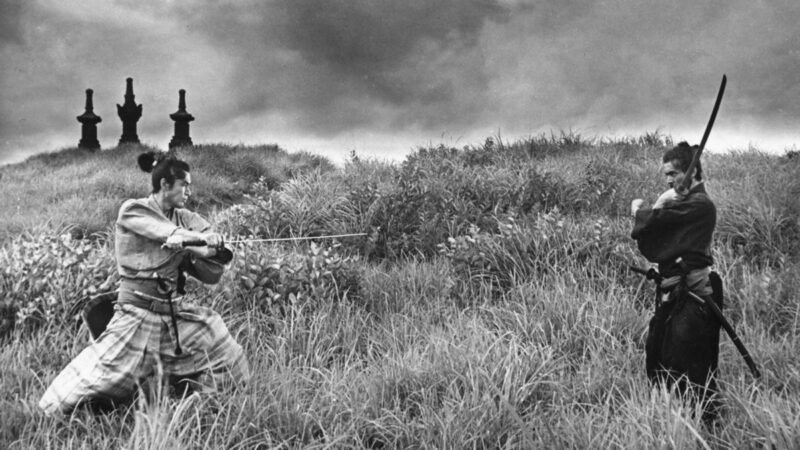
Why is Harakiri such a famous Japanese film?
Harakiri is a renowned Japanese film for several reasons. Its success is not merely due to its narrative content, but also due to its intelligent use of cinematic techniques, and its cultural and historical resonance.
One significant factor is the film’s unflinching critique of the samurai code of Bushido. The film presents a layered exploration of the concepts of honor and duty, questioning and deconstructing the societal constructs that uphold these ideals. It provides a searing critique of the oppressive social structures and the harsh realities faced by lower-class samurai, offering a perspective that is seldom explored in mainstream media.
From a technical standpoint, Harakiri stands out for its excellent screenplay, direction, and cinematography. The film’s storytelling is unique and highly immersive, with a non-linear narrative that effectively builds suspense and deepens the emotional impact of the story, that clearly influenced modern films like Pulp Fiction. The film’s use of visual symbolism, well-composed shots, and meticulous art direction lend it an aesthetic appeal that sets it apart.
The film’s cultural impact also plays a significant role in its fame. Released in 1962, during a period of rapid social and economic change in Japan, Harakiri offered a commentary on the societal norms and values of the time, resonating with audiences not just in Japan, but worldwide. The film’s exploration of themes such as honor, duty, and societal oppression provided a critical examination of universal human experiences, contributing to its global appeal.
Lastly, the performances in Harakiri, particularly Tatsuya Nakadai’s portrayal of Hanshirō Tsugumo, are universally acclaimed. The strong character development, combined with the film’s profound thematic depth, offer a compelling viewing experience that has cemented Harakiri as a classic in the annals of Japanese cinema.
Now it’s your turn
Have more unanswered questions about Harakiri? Are there themes or motifs we missed? Is there more to explain about the ending? Please post your questions and thoughts in the comments section! We’ll do our best to address every one of them. If we like what you have to say, you could become part of our movie guide!

